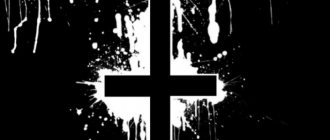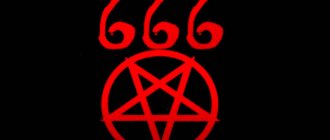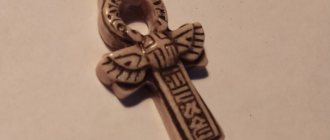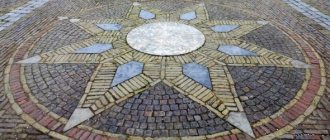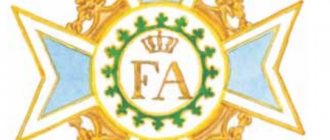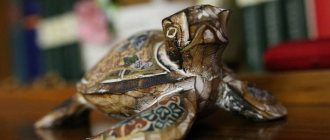Self-proclaimed “zealots of Orthodoxy” very often consider themselves experts in symbolism and, on this basis, are very fond of looking for anti-Christian symbols where they cannot exist in principle. At the same time, in their jealous fervor, zealots sometimes reach the point of blasphemy, calling ancient Christian symbols “Masonic” or “Satanic.” This happens both because of jealousy beyond reason and because of simple ignorance.
In this essay we will talk about some of the historical forms of Byzantine crosses. Some of them, unfortunately, become the target of poorly educated zealots out of reason.
Cross-reliquary of Emperor Justin II. Byzantium. OK. 580 Rome. Vatican Museums
Cross as a symbol
The development of the iconography of the Crucifixion as an event and the iconography of the Holy Cross as a symbol of the Crucifixion went in parallel. If on images of the Crucifixion of the Lord the cross usually had its historical form (with a title-tablet above the head and foot), then the Cross-symbol was more inclined towards a certain decorativeness. After all, the Cross of Christ is not just an instrument of execution, but also a symbol of victory over death, a symbol of atonement for human sins, a symbol of human salvation.
Therefore, starting with the adoption of Christianity by Emperor Constantine the Great, the cross became a triumphal sign and was included in the group of imperial symbols. From this time on, he receives, in a sense, autonomy from the iconography of the Crucifixion of Christ.
More specifically, the cross is often deprived of such attributes as a tablet with the inscription “Jesus of Nazareth, King of the Jews” and a foot. And in addition to its simple shape, its blades often widen somewhat towards the edges, and the edges themselves acquire rounded serifs, similar to those that we can see in the ceremonial fonts of early Byzantine manuscripts.
Mosaic crosses from Sophia of Constantinople
These are the types of crosses on the mosaics of Sophia of Constantinople. And this same shape of the cross was later borrowed by Western crusading knights as the basis for decorating their cloaks, gradually diversifying the original shape.
But if historical elements disappear from the symbolic sign of the cross, then elements are added, both decorative (for example, teardrop-shaped decorations at the corners of the blades of the cross or at the corners of the joints of the blades), and emphasizing one or another speculative meaning.
Meaning
According to Saint Maximus the Confessor (†662
.) “the whole spiritual world is mysteriously represented in symbolic images in the sensory world for those who have eyes to see, and the whole sensory world is contained in the spiritual world.”
The symbolism of the Cross has a history.
Man's knowledge of the mysterious sign of the cross extends back to the most ancient times; it has always been with man. For example, a cross in a circle is known to many ancient cultures as an image symbolizing light or fire (fire was made using sticks folded in a cross).
The cross was also understood as the unity of time and space - the crosshairs of the vertical and horizontal, i.e. the connection of everything is the center of life. The ancient Egyptian symbol - the key of life (ankh) is very similar to the cross. This ancient symbolism of the cross as the center or key of life was fully embodied in the New Testament through the crucifixion and Resurrection of Christ.
The Cross embraces everything, stretching to all ends - the most unattainable heavenly height and the very depth of suffering, throughout the entire space of the universe and for all times, imprinted on the entire Creation of God.
“Just as the four ends of the Cross are connected and united in the center, so the height, and depth, and longitude, and breadth, that is, all visible and invisible creation, are contained by God’s power.”
, says the Monk John of Damascus (†about 780).
The cross was an instrument of salvation according to the teachings of Gregory Palamas (†1359) even before Golgotha. Even in Old History, there are prototypes of the Cross everywhere: in the cross-shaped stacking of firewood on the shoulders of Isaac, who ascends the mountain to become a sacrifice (Gen. 22), in the symbolic crossing of hands when Jacob blessed the sons of Joseph (Gen. 48). Moses inscribed it on the waters of the Red Sea with his rod in order to translate the people, first dividing and then uniting the water (Ex. 14). The prototype of the Cross of Christ and the tree that sweetened the bitter waters of Marah (Exodus 15), and the serpent lifted up on the tree (Numbers 21) and many other images of the Old Testament.
The Crucifixion terrified Jews and non-believers. They saw in it only a terrible instrument of cruel and shameful execution, which was not used by the Jews. They remembered that the Law said, “Cursed is everyone who hangs on a tree” (Deut. 21:23).
But not all of them wanted to hear the apostle: “Christ has redeemed us from the curse of the law, having become a curse for us” (Gal. 3:13). Because “not everyone who hangs on a tree is cursed before God, but he who has sinned a sin worthy of death,” says Blessed Jerome (†420) to everyone.
The law prescribed the punishment of sin, but God is sinless. And Saint John Chrysostom (†407) confirms:
“Whoever wants to destroy an oath must himself be free from the oath, must take upon himself an undeserved oath - instead of a deserved one: Christ took such an oath upon Himself and with it destroyed the deserved one.”
The sinless One, having died for sinners, frees them from death. In spiritual blindness, people also forgot the prophecy of the great leader Moses: “your life will hang before you” (Deut. 28:66).
Even now, non-believers cannot understand how Christians carry the instrument of execution on themselves. Once, when asked to cross himself when entering a church, one “parishioner” answered me: “I’m not going to put a cross on myself.” Who is so afraid of the Cross? Cyril, Saint of Jerusalem (†386), explains:
“For this is the grace of God; a sign for the faithful and fear for evil spirits. Because through the Cross He conquered them, sovereignly putting them to shame (Col. 2:15). When they see the Cross, they remember the Crucified One. They are afraid of the dragon who crushed the head. Do not neglect this sign for the reason that it was given to you freely, but for this, honor the Benefactor all the more.”
The power of the Cross is great; the believer becomes convinced of it through experience and learns to always support his life with the sign of the cross, wearing and venerating the Cross of the Lord.
“The cross is a trophy against demons, a weapon against sin, the sword with which Christ pierced the serpent,”
- says John Chrysostom († 407) and compares the Cross to a lamp for the whole world.
The main symbolism of the Cross for every Christian should be the feat of following Christ and bearing one’s cross. Without humility before Him in your weaknesses, without assimilating His sacrificial love, without belittling yourself for the sake of Christ and your neighbor, without imitating Him in meekness and love for people, without crucifixion of your passions, without renouncing proud self-confidence, without patience in sorrows and illnesses, Without fulfilling His will, it is impossible to be His disciple. But how light is the cross with Him:
“Come to me, all you who labor and are heavy laden, and I will give you rest: take my yoke upon you, and learn from me, for I am meek and lowly in heart: and you will find rest for your souls: for my yoke is easy, and my burden is light” (Matthew .11:28-30).
“You have seen all the ends of the earth the salvation of our God”
Pectoral cross. Byzantium. XI century. USA. NY. Metropolitan Museum of Art
For example, discs appear at the edges of the cross, symbolizing the four ends of the world, since with the cross “you see all the ends of the earth the salvation of our God” (Ps. 97:3), as is sung at Matins in honor of the Exaltation of the Cross of the Lord.
It is in this form that the cross erected in the forum of the Byzantine capital is found in one of the ancient descriptions of Constantinople: “In the northern part of the forum there is a cross, as the great Constantine saw it in the sky, gilded and with round balls at the ends” [1].
As we can see, this form of the cross for Byzantium was already firmly associated with the vision of the Equal-to-the-Apostles Emperor Constantine, when before the decisive battle for the possession of imperial power, a golden cross appeared in the sky with the inscription: “By this you will win.”
For a long time, Byzantine craftsmen used this form, similar to the described “Cross of Constantine” (with ball-discs along the edges), to make portable processional crosses, which were carried in religious processions or other solemn processions. The same form of external crosses is typical not only for Byzantium itself, but also for the countries of the Byzantine cultural area - Georgia, Rus', etc.
Korsun cross from Novgorod. Drawing by F. Solntsev from “Antiquities of the Russian State”
Thus, crosses called “Korsun” were known in Rus', that is, taken from Korsun-Chersonese. They, obviously, were real Byzantine prototypes, which Equal-to-the-Apostles Prince Vladimir could have actually transported from Chersonesos after his wedding with the Byzantine princess Anna Porphyrogenitus. One of these “Korsun” crosses has survived to this day and is now presented in the museums of the Novgorod Kremlin.
The Novgorod cross has its own peculiarity, which, apparently, is more characteristic of processional crosses - at the bottom of its side blades, loops are partially preserved, on which drop-shaped pendants were once strung (such pendants are very characteristic of Byzantine jewelry art - they were used to decorate both sacred objects and details of imperial robes and regalia).
Constantine's cross. Cameo. 9th century USA. Baltimore. Walter Museum
Sometimes the “Constantine” cross has only one disk or ball - below at the very base, which in this context should mean that the cross affirms the whole earth, the king above it. One of the Byzantine regalia, which later passed to almost all European monarchs - the orb (a ball crowned with a cross) has the same meaning.
Features of the image of the Crucifixion
The image of the Crucifixion, which appeared much later, was the result of the development of the theological tradition - God incarnate and becoming a man could be depicted. But this image expressed the peculiarity of the theological views of East and West.
“By the cross of our Lord Jesus Christ, death was abolished, ancestral sin was resolved, hell was deprived of prey, the Resurrection was given, the power was given to us to despise the present and even death itself, the path to original bliss was prepared, the gates of heaven were opened, our nature was seated at the right hand of God, and we became children and heirs of God. All this was accomplished by the Cross."
, - John of Damascus (†about 780) spoke about the joy of victory.
This celebration required Christian art to depict Victory on the Cross. Until the 9th century, Christ was depicted on the Cross alive and even triumphant. Precious metals, gold, and stones were used to depict the celebration.
The deceased Christ began to be depicted only in the 10th century. In Catholic churches they began to use Crucifixes, depicting the suffering and torment of the Savior, and used naturalistic depiction techniques with muscle tension and a reflection of suffering on the face. By this naturalism one can distinguish a Catholic crucifix from an Orthodox one. The Orthodox Crucifixion is always an icon image, i.e. an image of the spiritual world, devoid of carnal characteristics and naturalness.
In addition, in the east, since ancient times, on the Crucifixion, Christ was depicted with his legs, each nailed with a separate nail. The depiction of the Savior with crossed legs, nailed with one nail, began in the West from the 13th century. Our Church has preserved the tradition of depicting Christ as Risen and embracing the whole world.
Orthodoxy invariably teaches that suffering is necessary for all sinners for their humble assimilation of the Fruit of redemption - the Holy Spirit sent by the sinless Redeemer, which, out of pride, Catholics do not understand, who through their sinful sufferings seek participation in the sinless, and therefore redemptive Passion of Christ and thereby fall into the crusader heresy "self-rescue". Hieromonk Adrian (Pashin).
Another form of the cross is a schematic image, without the Crucifixion, - the Schema Cross, which has many letter symbols. This is also an eight-pointed cross, towering over the symbol of Mount Golgotha, under which is a skull - the head of Adam, because From legend it is known that the crucifixion took place on the spot where the bones of ancient Adam had rested since ancient times. After the Crucifixion, the Blood of the New Adam fell upon them, washing away man's ancient sin. The cross is supplemented with an image of execution instruments - a cane (T) and a spear (K).
Thus, the image of the Schema cross is accompanied by the first letters of the (hidden) words: King of Glory, Son of God, Jesus Christ, Victorious (in Greek), GG - Mount Golgotha, GA - head of Adam, MLRB - “the place of execution was crucified.”
In Orthodox churches, after the service, prosphoras are distributed, which also depict a cross (there are also Mother of God with the symbol of the Mother of God). The “Prosphora Cross” is a special form of the cross, which also has letter signs: the Greek letters “IC.XP” and “NIKA”, which means the name of the Savior - the capital letters of the name Jesus Christ and “NIKA” - in Greek means Victory or Conqueror. This prosphora seal means the ransom of sinners from captivity to sin and death at a great price.
Four life-giving springs
Reliquary lid depicting the Cross, sheep and four springs. The Roman Empire. IV century. Italy. Cividali del Friuli. Cathedral of Santa Maria Assunta)
In some cases, four water springs can be seen at the base of the cross. In this case, a symbolic parallel is drawn between the tree of the cross and the Tree of Life in the middle of the biblical paradise, as well as the source, which was divided into four rivers: “And the Lord God made out of the ground every tree that was pleasant to the sight and good for food, and the tree of life in the midst of the garden, and the tree of the knowledge of good and evil. A river came out of Eden to water Paradise; and then it divided into four rivers...” (Gen. 2:9-10).
Cross with forthcoming angels and four springs. Syria. VI century. Russia. St. Petersburg, State Hermitage Museum
But now these sources acquire a speculative meaning: “Your life-giving side, like a fountain flowing from Eden, Thy Church, O Christ, like a verbal one, waters paradise, from here dividing into the beginning, into the four Gospels, watering the world, creating joy in creation, and faithfully teaching tongues to worship the Kingdom Yours" (service of the 12 Gospels on Maundy Thursday).
Requirements for a pectoral cross
The tradition of making crosses has a long history and a wide geographical distribution.
Therefore, in appearance, a Christian symbol can be four-, six-, or eight-pointed. In Russia, the most common is the eight-pointed cross with the figure of the Savior superimposed on it and the inscription “Save and Preserve” on the reverse side. The words mean wordless prayer addressed to God. There are no strict requirements for the material. You can buy a cross either made of simple wood or metal, or made of precious metals. The clergy do not condemn the desire to embellish the deeply revered symbol of Christianity. What the cross hangs on - a ribbon or a gold chain - also does not matter. The main thing is that it holds securely.
The pectoral cross must be blessed in church. The temple servant will not just sprinkle it with holy water, but will also read two special prayers so that the Lord will pour his power into the cross, which will protect the body and soul of the wearer from troubles, enemies and evil spirits.
Flourishing Cross
Flourishing cross. Reverse side of the icon of the Descent into Hell. Byzantium. X-XI centuries Georgia. Tbilisi. Art Museum
Even more specifically, a parallel is drawn with the heavenly Tree of Life in the image of the “flourished” cross. In this type of image, branches and leaves emerge from the base of the cross. Sometimes it is just a conventional floral ornament or a vine with leaves and clusters. In this context there is an additional eucharistic meaning.
Superstitions associated with the cross
You cannot lift someone else's cross.
The Church teaches on the contrary - it is not only necessary to lift the cross, but also to take it for yourself or give it to someone in need. Losing the cross threatens all sorts of troubles and misfortunes. Through the cross we partake of God's grace. Having lost the cross, we lose part of the divine power. Therefore, it is necessary to reacquire and consecrate the cross. But the voluntary removal of the cross is equated to apostasy. If you wear a cross and a zodiac sign at the same time, the owner’s magical protection will double. Religion condemns adherence to superstitions, idols, and witchcraft, so a churchgoer will not wear anything other than a cross. But security, personalized icons, prayer rings and other illuminated icons. The cross is an ancient and significant symbol. And in Orthodoxy it is of great importance. Here it is both a sign of faith and an indication of belonging to Christianity. The history of the cross is quite interesting. To learn more about this, consider Orthodox crosses: types and meaning.
Types of crosses and their meaning: Christianity and Orthodoxy
There are a huge variety of types of Orthodox and Christian crosses. Most of them come in the following form:
- straight;
- with extended beams;
- a square or diamond in the middle;
- curved ends of beams;
- triangular ends;
- circles at the ends of the beams;
- flourishing decoration.
The last form symbolizes the Tree of Life. And it is framed with floral patterns, where lilies, vines and other plants may be present.
In addition to differences in shape, Orthodox crosses have differences in type. Types of crosses and their meaning:
- St. George's Cross. Approved by Catherine the Great as a reward symbol for clergy and officers. This four-pointed cross is considered one of those whose shape is recognized as correct.
- Vine. This cross with eight ends is decorated with images of grape vines. It may have an image of the Savior in the center.
- Seven-pointed cross. Was common on 15th century icons. Found on the domes of old churches. In biblical times, the shape of such a cross served as the foot of the altar of the clergy.
- Crown of thorns. The image of a thorny crown on the cross signifies the torment and suffering of Christ. This type can be found on icons of the 12th century.
- Gallows-shaped cross. A popular look found on the walls of churches, on the clothes of church employees, and on modern icons.
- Maltese cross. Official cross of the Order of St. John of Jerusalem in Malta. It has equilateral rays that widen at the ends. This type of cross is issued for military courage.
- Prosphora cross. It is similar to St. George's, but has an inscription in Latin: “Jesus Christ is the winner.” Initially, such a cross was on three churches in Constantinople. According to Orthodox tradition, ancient words with the famous shape of a cross are printed on prosphoras, symbolizing the redemption of sins.
- Drop-shaped four-pointed cross. The drops at the ends of the beams are interpreted as the blood of Jesus. This view was depicted on the first leaf of a Greek Gospel dating from the 2nd century. Symbolizes the fight for faith to the end.
- Eight-pointed cross. The most common type today. The cross took its shape after Jesus was crucified on it. Before that, it was ordinary and equilateral.
The last form of the cross is the most common on sale. But why is this cross so popular? It's all about his story.
Andrey Szegeda: Christian cross - what is it like?
In today's material we will try to talk about what types of crosses there are. In particular, you will find out: whether there are “Orthodox” and “Catholic” crosses, whether a Christian can treat a cross with contempt, whether crosses are in the shape of an anchor, why we also venerate a cross in the shape of the letter “X” and much more interesting things.
Cross in the church
First, let's remember why the cross is important to us. The veneration of the cross of the Lord is associated with the atoning sacrifice of the God-man Jesus Christ. By honoring the cross, an Orthodox Christian pays veneration to God Himself, who became incarnate and suffered on this ancient Roman instrument of execution for our sins. Without the cross and death there would be no redemption, resurrection and ascension, there would be no establishment of the Church in the world and no opportunity to follow the path of salvation for every person.
Since the cross is so revered by believers, they try to see it as often as possible in their lives. Most often, a cross can be seen in a temple: on its domes, on sacred utensils and vestments of clergy, on the chests of priests in the form of special pectoral crosses, in the architecture of the temple, which is often built in the shape of a cross.
Cross behind the church fence
In addition, it is common for a believer to expand his spiritual space to the entire life around him. A Christian sanctifies all its elements, first of all, with the sign of the cross.
Therefore, in cemeteries there are crosses over the graves, as a reminder of the future resurrection, on the roads there are worship crosses, sanctifying the path, on the bodies of Christians themselves there are crosses on the body, reminding a person of his high calling to follow the path of the Lord.
Also, the shape of a cross among Christians can often be seen in home iconostases, on rings and other household items.
Pectoral cross
The pectoral cross is a special story. It can be made from a wide variety of materials and have all kinds of sizes and decorations, retaining only its shape.
In Russia, they are accustomed to seeing a pectoral cross in the form of a separate object hanging on a chain or rope on the chest of a believer, but in other cultures there were other traditions. The cross could not be made of anything at all, but applied to the body in the form of a tattoo, so that a Christian could not accidentally lose it and so that it could not be taken away. This is exactly how the Celtic Christians wore the pectoral cross.
It is also interesting that sometimes the Savior is not depicted on the cross, but an icon of the Mother of God or one of the saints is placed on the field of the cross, or even the cross is turned into something like a miniature iconostasis.
About the “Orthodox” and “Catholic” crosses and contempt for the latter
In some modern popular science articles, one can find the statement that an eight-pointed cross with a short upper and oblique short lower additional crossbars is considered “Orthodox”, and a four-pointed cross elongated at the bottom is “Catholic” and the Orthodox supposedly belong or in the past belonged to it with contempt.
This is a statement that does not stand up to criticism. As you know, the Lord was crucified on a four-pointed cross, which, for the above reasons, was revered by the Church as a shrine long before the Catholics fell away from Christian unity, which occurred in the 11th century. How could Christians despise the symbol of their salvation?
In addition, at all times, four-pointed crosses were widely used in churches, and even now on the chests of Orthodox clergy one can find several possible forms of the cross - eight-pointed, four-pointed and figured with decorations. Would they really wear some kind of “non-Orthodox cross”? Of course not.
Eight-pointed cross
The eight-pointed cross is most often used in the Russian and Serbian Orthodox Churches. This form recalls some additional details of the Savior’s death.
An additional short upper crossbar denotes the titlo - the tablet on which Pilate inscribed the guilt of Christ: “Jesus of Nazareth - King of the Jews.” In some images of the crucifixion, the words are abbreviated to form "INCI" - in Russian or "INRI" - in Latin.
The short oblique lower crossbar, usually depicted with the right edge raised up and the left edge down (relative to the image of the crucified Lord), denotes the so-called “standard of righteousness” and reminds us of the two thieves crucified on the sides of Christ and their posthumous fate. The right one repented before death and inherited the Kingdom of Heaven, while the left one blasphemed the Savior and ended up in hell.
St. Andrew's cross
Christians venerate not only a straight cross, but also an oblique four-pointed cross, depicted in the form of the letter “X”. Tradition tells that it was on a cross of this shape that one of the twelve disciples of the Savior, the Apostle Andrew the First-Called, was crucified.
The “St. Andrew’s cross” is especially popular in Russia and the Black Sea countries, since it was around the Black Sea that the missionary path of the Apostle Andrew passed. In Russia, the St. Andrew's cross is depicted on the flag of the navy. In addition, the St. Andrew's cross is especially revered by the Scots, who also depicted it on their national flag and believe that the Apostle Andrew preached in their country.
T-cross
This cross was most common in Egypt and other provinces of the Roman Empire in North Africa. Crosses with a horizontal beam superimposed on a vertical post, or with a crossbar nailed just below the top edge of the post, were used to crucify criminals in these places.
Also, the “T-shaped cross” is called the “cross of St. Anthony” in honor of the Venerable Anthony the Great, who lived in the 4th century, one of the founders of monasticism in Egypt, who traveled with a cross of this shape.
Archbishop's and Papal crosses
In the Catholic Church, in addition to the traditional four-pointed cross, crosses with second and third crossbars above the main one are used, reflecting the hierarchical position of the bearer.
A cross with two bars signifies the rank of cardinal or archbishop. This cross is sometimes also called the “patriarchal” or “Lorraine”. The cross with three bars corresponds to papal dignity and emphasizes the high position of the Roman Pontiff in the Catholic Church.
Lalibela Cross
In Ethiopia, church symbolism uses a four-pointed cross surrounded by a complex pattern, which is called the “Lalibela cross” in honor of the holy Negus (king) of Ethiopia Gebre Meskel Lalibela, who ruled in the 11th century. Negus Lalibela was known for his deep and sincere faith, assistance to the Church and generous giving of alms.
Anchor cross
On the domes of some churches in Russia you can find a cross that stands on a crescent-shaped base. Some mistakenly explain such symbolism as wars in which Russia defeated the Ottoman Empire. Allegedly, “the Christian cross tramples the Muslim crescent.”
This shape is actually called the Anchor Cross. The fact is that already in the very first centuries of the existence of Christianity, when Islam had not even arisen, the Church was called the “ship of salvation”, which delivers a person to the safe haven of the Heavenly Kingdom. The cross was depicted as a reliable anchor on which this ship could wait out the storm of human passions. The image of a cross in the form of an anchor can be found in the ancient Roman catacombs where the first Christians hid.
Celtic cross
Before converting to Christianity, the Celts worshiped various elements, including the eternal luminary - the sun. According to legend, when Saint Patrick enlightened Ireland, he combined the symbol of the cross with the earlier pagan symbol of the sun to show the eternity and importance for each convert of the Savior's sacrifice.
Chrism - a hint of the cross
During the first three centuries, the cross, and especially the Crucifixion, were not depicted openly. The rulers of the Roman Empire began a hunt for Christians and they had to identify each other using not too obvious secret signs.
One of the hidden symbols of Christianity closest to the cross in meaning was “chrism” - a monogram of the name of the Savior, usually made up of the first two letters of the word “Christ”, “X” and “R”.
Sometimes symbols of eternity were added to the “chrism” - the letters “alpha” and “omega” or, as an option, it was made in the form of an St. Andrew’s cross crossed out by a transverse line, that is, in the form of the letters “I” and “X” and could be read as "Jesus Christ".
There are many other varieties of the Christian cross, which are widely used, for example, in the international award system or in heraldry - on the coats of arms and flags of cities and countries.
Andrey Szegeda
Dear friends! I opened my own blog! If you are interested in reading my articles, please support me by subscribing and reposting!
You can applaud the author (at least 10 times)100
Orthodox cross: a little history
The cross as a symbol is used in many world beliefs. But for Christians it initially did not have a very good meaning. Thus, the guilty Jews were executed first in three ways, and then a fourth was added. But Jesus managed to change this order for the better. And he was crucified on a pillar with a crossbar, reminiscent of a modern cross.
Thus, the sacred sign firmly entered the life of Christians. And it became a real protective symbol. In Rus', a person with a cross around his neck inspired trust, and they tried not to do any business with those who did not wear a cross. And they said about them: “There is no cross on them,” meaning a lack of conscience.
We can see crosses of various formats on the domes of churches, on icons, on church paraphernalia and as decorations on believers. Modern Orthodox crosses, the types and meanings of which can vary, play an important role in the transmission of Orthodoxy throughout the world.
Signs and superstitions associated with the pectoral cross
The cross is given to a person during baptism. After this sacrament, the church decoration must be worn almost without taking off. Some believers even wash themselves wearing their crosses for fear of losing them. But what does it mean when the cross is lost?
Many Orthodox people believe that the loss of a cross is a sign of impending disaster. To ward it off, Orthodox Christians fervently pray, confess and receive communion, and then acquire a new consecrated cross in the church.
Another sign is related to the fact that you cannot wear someone else’s cross. God gives each person his own burden (cross, trials), and by putting on someone else’s badge of faith, a person takes on someone else’s difficulties and fate.
Today, family members also try not to wear each other’s crosses. Although previously, a cross decorated with precious stones was passed down from generation to generation and could become a real family heirloom.
A cross found on the road is not raised. But if they pick it up, they try to take it to church. There it is consecrated and purified again, and given to those in need.
Many priests call all of the above superstitions. In their opinion, anyone can wear a cross, but you need to make sure that it is consecrated in the church.
Consecration of the pectoral cross
Another very important issue is the consecration of the pectoral cross. If a cross is purchased at a temple shop, then it is usually consecrated. If the cross was purchased elsewhere or has an unknown origin, then it must be taken to the church, ask one of the temple servants or the worker behind the candle box to transfer the cross to the altar. After examining the cross and if it complies with Orthodox canons, the priest will serve the rite prescribed in this case. Usually the priest blesses the crosses during the morning prayer service. If we are talking about a baptismal cross for a baby, then consecration is possible during the Sacrament of Baptism itself.
When consecrating the cross, the priest reads two special prayers in which he asks the Lord God to pour heavenly power into the cross and that this cross will protect not only the soul, but also the body from all enemies, sorcerers and all evil forces. That is why many pectoral crosses have the inscription “Save and Preserve!”
In conclusion, I would like to note that the Cross must be revered with its correct, Orthodox attitude towards it. This is not just a symbol, an attribute of faith, but also an effective protection of a Christian from satanic forces. The cross must be honored both by actions, and by one’s humility, and by imitation of the Savior’s feat, as far as possible for a limited person. The rite of monastic tonsure says that a monk must always have the suffering of Christ before his eyes - nothing makes a person gather himself, nothing so clearly shows the need for humility as this saving memory. It would be good for us to strive for this. It is then that the grace of God will actually act in us through the image of the sign of the cross. If we do it with faith, we will truly feel God's power and know God's wisdom.
Material prepared by Ignatova Natalya
